
|  |
Real Buildings that Inspired
Disney’s California Adventure,
Part 2
|
IMAGINEERING

|
|
Last week, Yesterland published Real Buildings that Inspired Disney’s California Adventure, Part 1.
The Hollywood Pictures Backlot section of Disney’s California Adventure and the streets of Disney-MGM Studios (now Disney’s Hollywood Studios) both have carefully detailed façades based on actual Los Angeles area buildings of the 1920s and 1930s.
But the results feel quite different.
First, let’s look at four more buildings.
Then I’ll suggest how these two re-created Hollywoods are different—and why I prefer the East Coast version.
|
 , Curator of Yesterland, January 18, 2008 , Curator of Yesterland, January 18, 2008
|
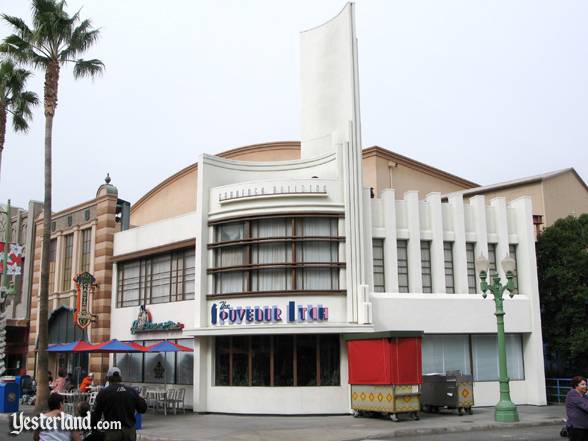
Disney: Souvenir Itch, a souvenir shop that you can’t enter
|
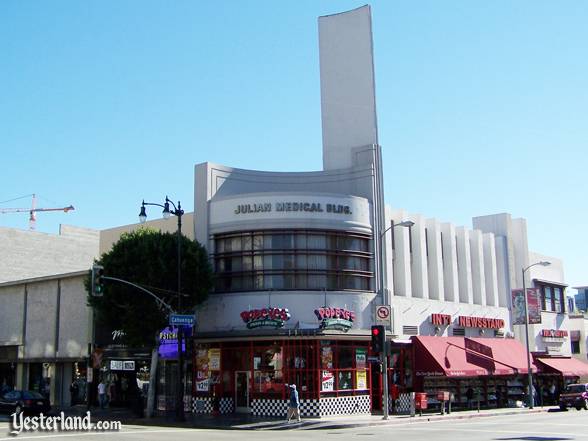
The inspiration: Owl Drug, 6382 Hollywood Blvd., Hollywood
|
|
The Owl Drug Company Building (1933), designed by the firm of Morgan, Walls and Clements, is a masterpiece of Streamline Moderne architecture.
The graceful curved corner and tower face the intersection of Hollywood Blvd. and Cahuenga Blvd.
Originally, the ground floor was a drug store.
World Book & News has long occupied the Cahuenga side of the building;
it’s open 24 hours and is said to be the largest newsstand in California.
From the beginning, medical offices occupied the second floor, where
various doctors, including holistic and alternative practitioners, still have offices today.
The corner is now a Popeye’s Chicken & Biscuits location.
|
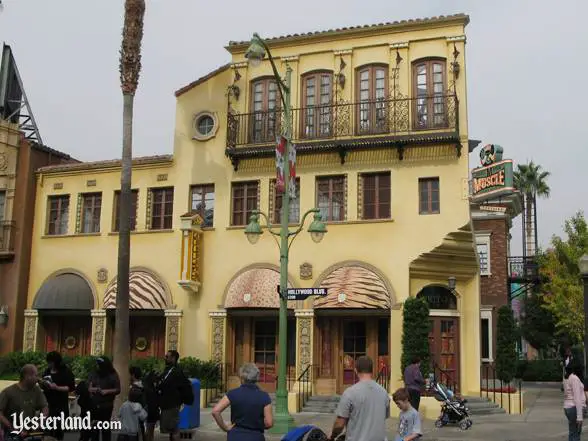
Disney: The Whitley Building, a façade only
|
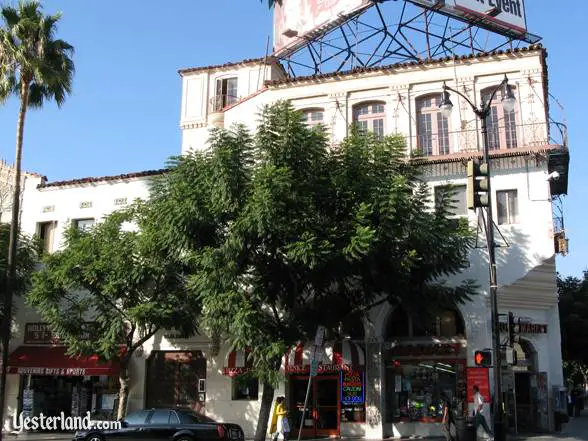
The inspiration: Baine Building, 6601 Hollywood Blvd., Hollywood
|
|
The name above the corner door in the Disney version says Whitley.
That’s a reference to the location of the building after which it was modeled—the corner of Hollywood Blvd. and Whitley Ave.
The Baine Building (1926), designed by firm of Gogerty and Weyl, was built by Harry M. Baine.
Col. Baine was a prominent businessman and Hollywood booster who became a Los Angeles County Supervisor a few years after this building opened.
There’s also a version of the Baine Building at Disney’s Hollywood Studios, where its function and location are equivalent to the Main Street Emporium at Disneyland Park and Magic Kingdom Park.
|
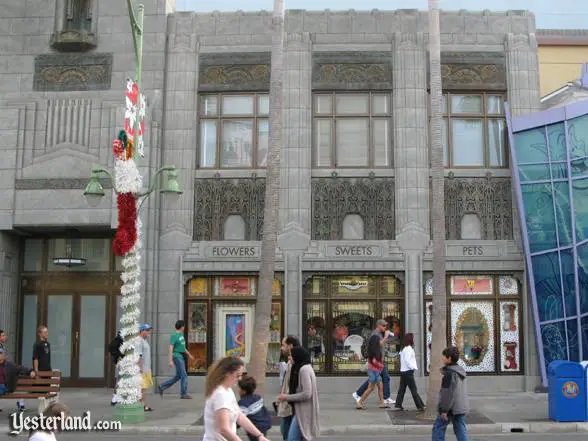
Disney: Flowers, Sweets, Pets, a decorative façade only
|

The inspiration: Pantages Theatre, 6233 Hollywood Blvd., Hollywood
|
|
If you look at the Hollywood Pictures Backlot façade with its signs, “Flowers, Sweets, Pets,” you might guess that it’s based on a department store or perhaps an office building or a bank.
It was actually based on the famed Pantages Theatre in Hollywood—but only the part of the Pantages that’s to the left of the theater’s entrance and marquee, which is why the Disney version doesn’t look like a theater.
The real Pantages, designed by architect B. Marcus Priteca, was opened in 1930 by showman Alexander Pantages, for whom Priteca designed 22 theaters.
It was one of Hollywood’s great movie palaces, with a spectacular Art Deco interior and exterior, 2,700 seats (later expanded to 2,800 seats), and the largest theater lobby in Los Angeles.
The illustrious history of the Pantages includes being the site of the 1949 though 1959 Academy Awards ceremonies, with the 1952 Academy Awards being televised for the first time.
Howard Hughes had his personal offices in the building after he bought the Pantages in 1949 for his RKO Theatre Circuit.
In 1977, the Pantages was converted from a movie theater to a live theater.
After a $10-million restoration and upgrade of the Pantages in 2000,
Disney’s stage version of The Lion King ran there for over two years.
In December 2007, the owners of the Pantages announced plans to add ten additional floors to the building.
It turns out the original plan eight decades ago called for these additional floors.
In fact, the foundation was built for a 12-story structure, but the money ran out after the 1929 stock market crash.
So the building opened with just two stories, and that’s how it’s been ever since.
The building will be completed according to the original Art Deco drawings.
|
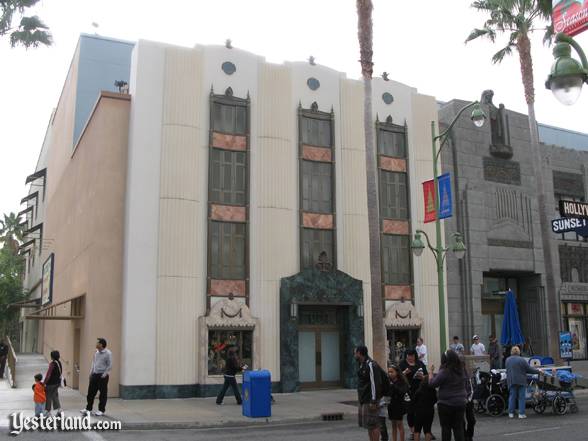
Disney: Role Models, a decorative façade only
|
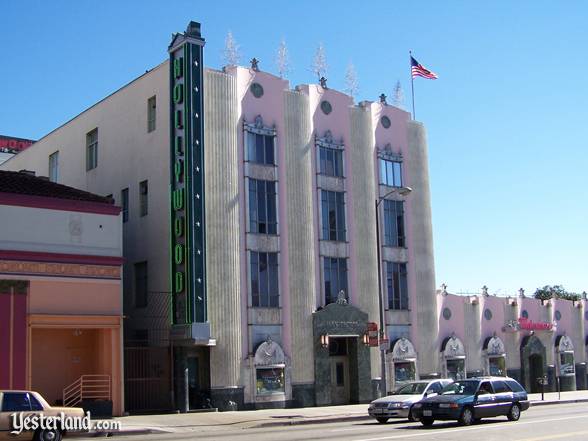
The inspiration: Max Factor Building, 1660 North Highland Ave., Hollywood
|
|
Role Models in the Hollywood Pictures Backlot is modeled after one of Hollywood’s better known landmarks—the Max Factor Building.
Max Factor is known today as one of Procter & Gamble’s makeup brands, but there was a real Max Factor.
He was born in 1877 in Lodz, Poland, as Max Faktor.
Coming to America in 1904, he Americanized the spelling of his name.
After selling perfume and cosmetics at the St. Louis World’s Fair in 1904, Factor opened a cosmetics store in the theater district of Los Angeles the same year.
Ten years later, he began earning his reputation as the make-up genius of the motion picture industry.
In 1931, Factor commissioned theater architect S. Charles Lee to transform a four-story building into what became the Max Factor Building.
Lee combined 19th century Regency period elements with Art Deco, resulting in a style that’s sometimes identified as Regency Deco.
A version of the four-story Max Factor Building can be also be found at Universal Studios Orlando, while the one-story part has a counterpart at Disney’s Hollywood Studios.
In the real Hollywood, the four-story part of the Max Factor Building is now Hollywood Museum, and the one-story part is now Mel’s Drive-In, a retro diner.
|
Comparing the Florida and California Versions
At Disney’s Hollywood Studios (originally Disney-MGM Studios), the Hollywood Blvd. and Sunset Blvd. streets epitomize the park’s theme of “the Hollywood that never was and always will be.”
The streets are idealized versions of Hollywood streets from the Golden Age of Hollywood.
In Florida, guests walk past active store fronts, while street performers play the parts of Hollywood citizens of long ago.
The streets themselves have the intimate scale of Main Street at Disneyland Park, rather than the more grandiose scale of Main Street at Magic Kingdom Park.
As noted in the article Real Buildings that Inspired Disney-MGM Studios, the care that the Imagineers put into the Florida version of Hollywood paid off.
|
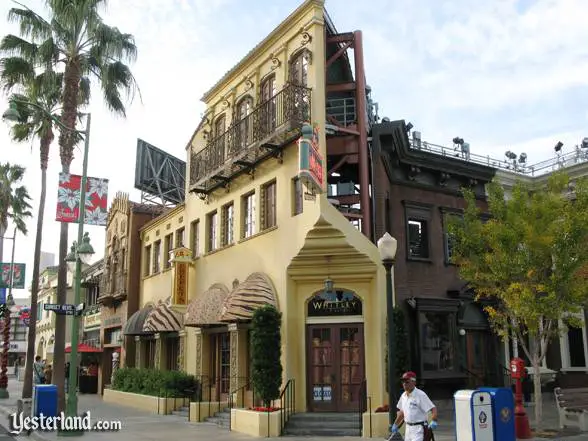
Ha, ha, ha. It’s all just fake.
|
|
When planning Disney’s California Adventure, the decision makers had a different idea.
Sure, the Disney-MGM Studios approach worked well 12 years earlier.
But this Hollywood wouldn’t be an idealized Hollywood district; it would be a backlot, an outdoor movie set of false fronts that look like Hollywood.
As guests enter the Hollywood Pictures Backlot, they might think it’s a real street.
But as they continue to walk in, they would discover it’s all just movie studio magic.
There’s only one problem with this approach.
It isn’t very magical.
While other themed lands at Disney parks are carefully designed environments that immerse guests in other places and times, the Hollywood Pictures Backlot constantly reminds guests that everything is fake—and it’s not even particularly good at being fake because it keeps contradicting itself.
|

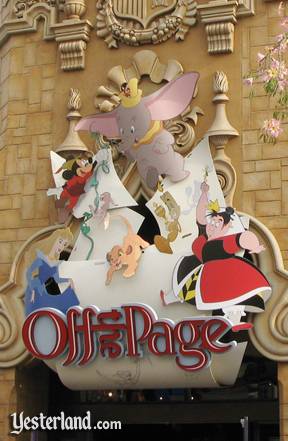
|

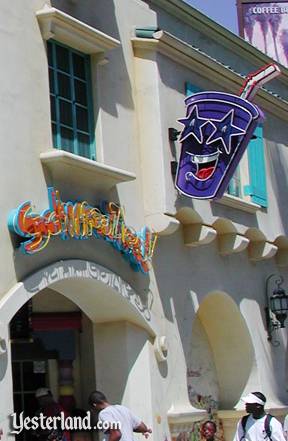
|
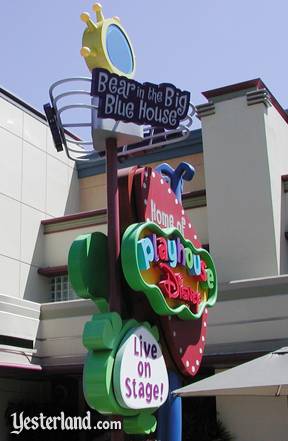

Examples of signs...
|
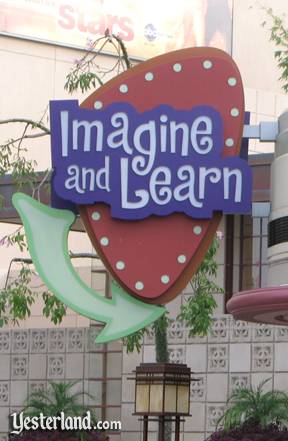

...that don’t fit in
|
|
The Hollywood Pictures Backlot is not believable as a movie backlot.
And it’s doesn’t succeed as an immersive environment either.
Let’s look at what’s wrong:
- The false fronts come across as an attempt to save money, not as an effort to capture the essence of a studio backlot.
- Real backlots at real movie studios provide convincing backgrounds for movie action.
Without leaving Southern California, filmmakers can set their films in 19th-century Paris or the old West or ancient Rome or wherever else they want.
The Hollywood Pictures Backlot fails to represent a particular period that might be the setting for a movie.
- Too many of the façades are just decorated walls rather than entrances to shops, restaurants, or attractions.
Did you notice that guests cannot enter any of Disney “buildings” on this page?
I’m sure the explanation is that it’s because it’s a backlot, not a real street—but from a guest perspective, it just comes across as a street with too many uninviting, locked doors.
- The signs don’t go with the buildings.
While some smaller signs set a tone of the 1920s and 1930s, others are out-of-place, gaudy, contemporary signs that your local shopping mall probably would not allow.
- The Postmodern Deco Revival style of the Disney Animation entrance is completely out-of-place.
- Show buildings loom above the façades.
|
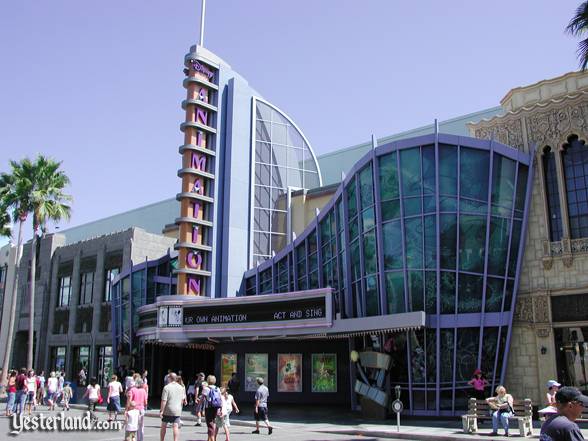
What were they thinking?
|
|
Sorry.
This isn’t meant to be the millionth article bashing Disney’s California Adventure.
By approving a billion dollars to fix the park, the current management of The Walt Disney Company has effectively acknowledged that previous management made serious mistakes.
It’s likely that at least some of this money will go toward transforming the current Hollywood Pictures Backlot into a delightful, idealized Hollywood street.
It’s not necessary to start over.
It’s just a matter of fixing what’s already there.
The historic façades were beautifully designed and crafted.
Just think how nice the Chapman Market tower would look if the Churrigueresque details weren’t obliterated by the huge, character-encrusted “Off The Page” sign.
|
© 2008-2011 Werner Weiss — Disclaimers, Copyright, and Trademarks
Updated March 22, 2011.
Photo of Disney’s Souvenir Itch: 2007 by Werner Weiss.
Photo of Owl Drug, 6382 Hollywood Blvd., Hollywood: 2007 by Chris Bales.
Photo of Disney’s The Whitley Building: 2007 by Werner Weiss.
Photo of Baine Building, 6601 Hollywood Blvd., Hollywood: 2007 by Werner Weiss.
Photo of Disney’s Flowers, Sweets, Pets: 2007 by Werner Weiss.
Photo of Pantages Theatre, 6233 Hollywood Blvd., Hollywood: 2010 by Chris Bales.
Photo of Disney’s Role Models: 2007 by Werner Weiss.
Photo of Max Factor Building, 1660 North Highland Ave., Hollywood: 2007 by Chris Bales.
Photo of false front at Hollywood Pictures Backlot: 2007 by Werner Weiss.
Photo of 'Off the Page' sign: 2007 by Werner Weiss.
Photo of Schmoozies sign: 2007 by Werner Weiss.
Photo of Playhouse Disney sign: 2006 by Werner Weiss.
Photo of 'Imagine and Learn' sign: 2007 by Werner Weiss.
Photo of Disney Animation entrance: 2006 by Werner Weiss.
|
|